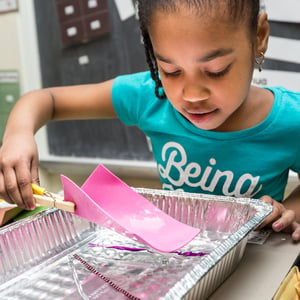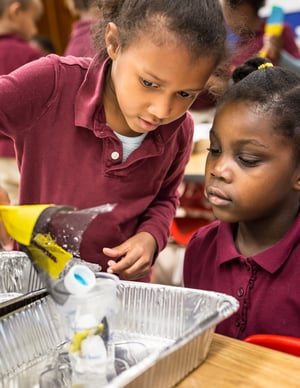 Hands-on engineering activities empower young children to see themselves as problem solvers. They learn that there’s more than one way to solve a problem, and that it’s okay to fail and try again. A classroom-tested engineering design challenge with an age-appropriate engineering design process will provide fun and engaging opportunities for the youngest learners. We found in creating our early childhood curricula that engineering activities should look different in preschool in comparison to kindergarten. Learn about those differences below and why age-appropriate engineering activities are so important.
Hands-on engineering activities empower young children to see themselves as problem solvers. They learn that there’s more than one way to solve a problem, and that it’s okay to fail and try again. A classroom-tested engineering design challenge with an age-appropriate engineering design process will provide fun and engaging opportunities for the youngest learners. We found in creating our early childhood curricula that engineering activities should look different in preschool in comparison to kindergarten. Learn about those differences below and why age-appropriate engineering activities are so important.
Additionally, if you'd like to learn more about early childhood STEM, sign up for our free email course Early Childhood STEM: Building the Foundation.
Following the Steps of an Engineering Design Process (EDP)
The engineering design process is central to engineering.Teaching kids a process for solving problems sets them up for success, but even between the ages of 3 - 6, there are huge developmental differences and best practices to consider.
For preschoolers, the EDP helps them slow down their thinking. We developed a three-step EDP for this age group because research shows that preschoolers are better at remembering things that come in threes. We even made a song to help them remember it!
But by kindergarten, three steps will be too easy. Children can learn how to follow a longer process. For EiE for Kindergarten, children follow a five-step EDP-- the same EDP as our Engineering is Elementary curriculum. We simplify it for younger learners by including visual icons to help children associate the steps of the EDP with an action.
What’s the Goal?
Each young engineer’s goal is to create a technology that has a specific, measurable function, but that function becomes more complex as they age.
In preschool, children design a technology that has a simple function. For example, in Wee Engineer, preschoolers create a noisemaker. We provide the model of the noisemaker, the children focus on which materials to use to finish the technology and make sure it fulfills the criteria.
Going into Kindergarten, children are ready to practice cutting, taping, and building so the technology they design can be more complex in terms of structure and shape while still having a simple function. For example, with EiE for Kindergarten, children build a trash collector.
Working in Teams
Engineering is a collaborative activity, but working together with a common goal doesn’t come naturally to young learners.
Preschoolers are still learning how to share and compromise so it’s best to have them work alone or in freely formed groups with the teacher praising successful interactions.
This is crucial so that by kindergarten, children are familiar with working alongside each other and can now work in pairs and share their materials with each other. Watch how these two girls test out materials together with their teacher's support.
Analyzing Data for Planning and Redesign
Being able to evaluate data is a crucial skill for the 21st century workforce and touches every sector students are likely to enter in the future. Students need to learn not just how to track data, but change that data into true, measurable impact.
 In preschool, children just need an opportunity to test and judge the success of their design. Their tests should be very simple only evaluated on a straightforward criterion. For example, if with teacher support they’re able to make a judgement on how successful their wrecking ball is by how many blocks fell down during their test, then they’re on the right track!
In preschool, children just need an opportunity to test and judge the success of their design. Their tests should be very simple only evaluated on a straightforward criterion. For example, if with teacher support they’re able to make a judgement on how successful their wrecking ball is by how many blocks fell down during their test, then they’re on the right track!
As children transition into kindergarten, they learn how to observe and evaluate on their own. With minimal teacher support they’re able to remark whether their design meets the criterion. We provide prompts and opportunities for them to do so. They work with their teachers to construct charts (or graphs), and even more importantly, teachers can start encouraging children to the use data (the results of their design tests) to improve their creations.
Want to integrate STEM into your Preschool or Kindergarten? Our free email course will help you get started. Our introductory course, Early Childhood STEM: Building the Foundation, was designed to work into your busy schedule, allowing you to learn at your own pace. In this course we provide an overview of STEM in early childhood: what it is, how kids learn it, and how STEM benefits your youngest learners.










